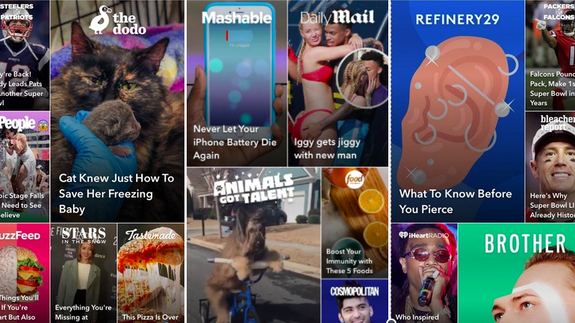Snapchat Discover is cracking down on sex, clickbait and fake news

Snapchat doesn't need your clickbait.
The mobile storytelling platform, once popularized as a sexting app, is cracking down on sexually explicit and deceptive content within Discover, the publisher section of the app, the company announced Monday.
SEE ALSO: Snapchat makes biggest move yet in becoming the new TV
Snap Inc., Snapchat's parent company, unveiled new content guidelines that "prohibit sensitive content, including profanity, overly sexualized content, and violent content" from cover images and require warnings before other "shock" content, according to Snap.
While Snapchat has always had guidelines for its publishing partners and worked hand-in-hand advising them on what to include and what to avoid, this announcement is the first time the app has been more stringent and explicit since launching almost two years ago to date. (Mashable is a Discover partner.)
"We take the responsibility of being a source of news, entertainment and information for our community of more than 150 million daily active Snapchatters very seriously," a Snap spokesperson said in an emailed statement. "Our updated Content Guidelines will help our editorial partners tell these stories."
What happened?
The changes, Snap said, were made in part as a response to the feedback they received from users and publishers. Snapchat users have long been aware of sexually explicit content on Discover:
there's, um, a lot of sex stuff on snapchat discover today. pic.twitter.com/jQUg4Sk6D4
— Maya Kosoff (@mekosoff) September 30, 2016
I love Snapchat, but wish Discover contained more substance than celebrity divorces, Kimye’s boobs, or food that kills your sex drive.
— Heath W. Black (@heathwblack) September 20, 2016
Snapchat Discover headlines are the most click-baity headlines ever written.
Example: "Why I Pretended to Be a Sex Tourist"— John Linitz (@jlinitz) June 28, 2016
The proliferation of sex-related content in Discover, in fact, inspired one 14-year-old boy to file a lawsuit against Snapchat last July. That came shortly after Snapchat redesigned its app to allow publishers to create magazine-like covers for their editions instead of just having circular logos, thereby broadcasting more photos to users without their explicit approval and spurring a new wild west for clicks.
Snapchat had conversations with publishers following the suit, which pushed them to tone down what was shared. However, there was no formal agreement. That suit later was dismissed.
The changes also follow a rise of conversation around the spread of fake news. Snapchat has positioned itself as a network free from misleading news and propaganda while Facebook is plagued by it.
"Social media companies tell us what to read based on what’s most recent or most popular. We see it differently. We count on editors and artists, not clicks and shares, to determine what’s important," Snapchat wrote in the blog post announcing Discover back in 2015.
Clearer guidelines also help Snapchat as they onboard new publishers. It also better positions Snapchat as a stable and strong company to Wall Street investors as its eyes an initial public offering later this year.
What's new
Snap outlined four key updates in its updated content guidelines.
The first centers around what is showed in a tile, or the cover image. Those cannot have any kind of profanity, sexualized content such as nude bodies, sex acts or sex toys.
The guidelines also forbid repeated use of clothed but sexualized bodies — for instance what you may see on Monday's Discover edition of The Daily Mail.
Don't worry, team, celebs in bikinis definitely still allowed in Snapchat Discover under new content guidelines pic.twitter.com/K9YHdK5rI3
— Kerry Flynn 🐶 (@kerrymflynn) January 23, 2017
The guidelines then have specific rules for subscribers as well as topsnap and longform content.
The above guidelines can be tweaked if there is a sufficient newsworthy value to what is being shown. Snap does require that publishers to have a warning before any violent content, as the company itself has done. For instance, for a recent Snapchat-curated Our Story around the shooting at the Fort Lauderdale airport, Snap included a 10-second warning image prior to a video showing blood on the tarmac.
In regards what some may categorize as addressing fake news, the guidelines state that publishers must properly fact-check any articles and images. Publishers are forbidden to link to any misleading or fraudulent content.
Snapchat is releasing a tool next month that will allow publishers to limit specific content to users above the age of 18. This "age-gating" feature has been available to advertisers, allowing alcohol brands to show video ads and geo-filters to those above 18. When turned on, this function applies to the entire edition.
Building more
The changes weren't shocking to publishers, who are all in continuous conversations with Snapchat. All editions published Monday were reflective of the new guidelines.
"Our relationships with our editorial partners are vital to us," a Snap spokesperson said in an email. "We have immense respect for their editorial perspectives, prioritize their editorial independence and want to help them achieve the loyalty and trust of our community through substantial, sourced and rewarding content."
About 100 million of Snapchat's 150 million daily active users are using Discover, so far. But Snap touts more than those statistics when pitching publishers, advertisers and investors. Internally and with partners, Snap shares return visitors within three-day and week-long periods. Snap also emphasizes completion, or click-through, and watch time.
“Snapchat thinks about the role that its content plays in the lives of consumers differently,” Steven Kydd, one of the founders of Tastemade, a Discover partner, told The New York Times. “This is cable all over again, except for a mobile and global audience.”

